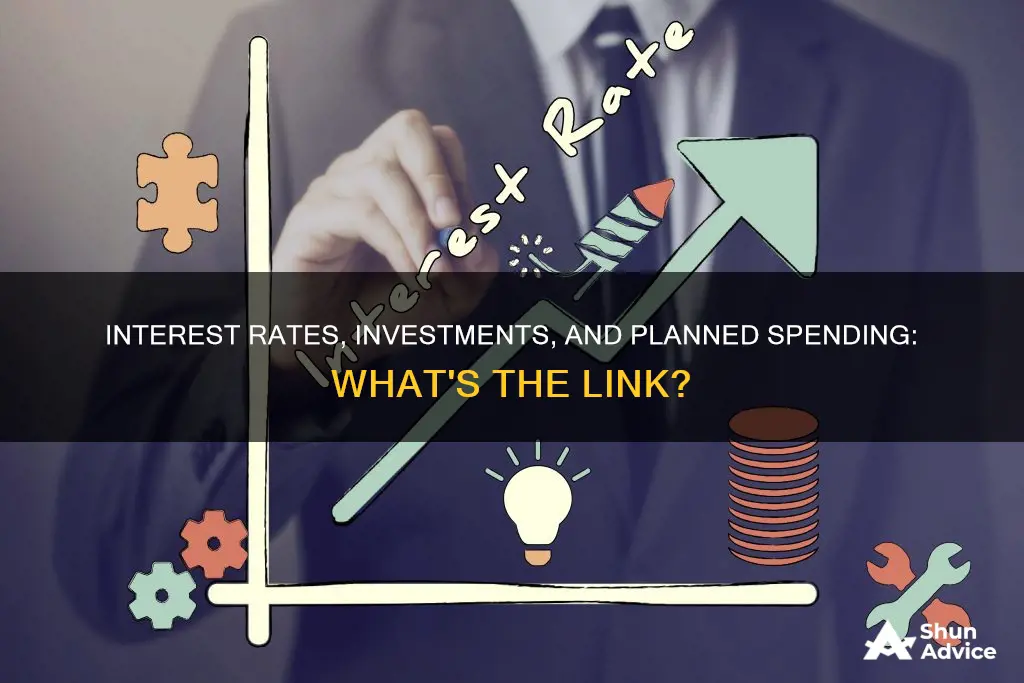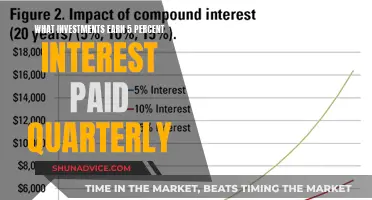
Interest rates and investment are key factors in determining planned aggregate expenditure. Interest rates affect the cost of borrowing, which in turn impacts investment spending. As interest rates increase, the cost of borrowing rises, leading to a decrease in investment and aggregate expenditure. Conversely, lower interest rates make borrowing cheaper, encouraging investment and resulting in higher aggregate expenditure. Investment itself is a significant driver of aggregate expenditure, as it involves substantial upfront expenditures with the expectation of future profits. The potential for future profitability influences firms' willingness to take on investment risks, impacting their investment decisions and, consequently, aggregate expenditure.
| Characteristics | Values |
|---|---|
| Interest rates | As interest rates increase, the cost of borrowing increases, reducing investment spending and aggregate expenditure. |
| Higher interest rates also increase the foreign exchange rate with other currencies, increasing the cost of exports while decreasing the cost of imports. | |
| Lower interest rates have the opposite effect, increasing aggregate expenditure. | |
| Investment | Investment requires a large upfront expenditure with the hope of earning future profits. |
| As firms expect greater future profitability, their appetite for investment risk will increase. | |
| An increase in expected future profit will lead to more investment, while a decrease in expected future profit will lead to a reduction in investment. |
What You'll Learn
- How the real interest rate affects the cost of borrowing?
- How the real interest rate affects the cost of investment spending?
- How the real interest rate affects the foreign exchange rate?
- How the real interest rate affects the opportunity cost of consumption?
- How the real interest rate affects the economy's potential output?

How the real interest rate affects the cost of borrowing
The real interest rate has a direct impact on the cost of borrowing. As the real interest rate increases, the cost of borrowing also increases. This is because the real interest rate dictates the cost of investment spending. When the cost of borrowing is high, firms are less likely to take on the risk of investment as they will have to pay more upfront. This results in a decrease in aggregate expenditures as durable good purchases fall.
On the other hand, a decrease in the real interest rate makes it cheaper to borrow and will therefore lead to an increase in aggregate expenditure. Lower interest rates increase consumption and lower savings. This is because when interest rates are low, savers will save less, borrow more, and spend more.
The impact of the real interest rate on the cost of borrowing is also influenced by expectations about future prices and income. For example, if people are concerned about their future income, they will reduce their consumption spending at all levels of disposable income.
Additionally, higher real interest rates can increase the foreign exchange rate with other currencies, making imports cheaper and exports more expensive. This further impacts aggregate expenditure as more of the national income is spent on imports, while net exports decline.
Interest: Friend or Foe to Your Investment Earnings?
You may want to see also

How the real interest rate affects the cost of investment spending
The real interest rate has a direct impact on the cost of investment spending. As the real interest rate increases, the cost of borrowing also increases, which results in a decrease in aggregate expenditures as durable good purchases fall. This is because investment requires a large upfront expenditure with the hope of earning future profits. Therefore, as the cost of borrowing increases, investment spending decreases.
On the other hand, a decrease in the real interest rate makes it cheaper to borrow and will therefore lead to an increase in aggregate expenditure. This is because a decrease in the real interest rate increases consumption and lowers savings.
The real interest rate also affects the foreign exchange rate with other currencies, increasing the cost of exports while decreasing the cost of imports. This results in more of the national income being spent on imports, while net exports decline.
Therefore, the real interest rate has a significant impact on the cost of investment spending, with higher interest rates leading to decreased investment spending and lower interest rates leading to increased investment spending.
Interest Rate Hike: Impact on Your Investments
You may want to see also

How the real interest rate affects the foreign exchange rate
As the real interest rate increases, the cost of borrowing also increases. This results in a decrease in aggregate expenditures as durable good purchases fall. The real interest rate also increases the foreign exchange rate with other currencies, increasing the cost of exports while decreasing the cost of imports. This means that more of the national income is spent on imports, while net exports decline.
On the other hand, a decrease in the real interest rate makes it cheaper to borrow and will therefore lead to an increase in aggregate expenditure. Lower real interest rates decrease the foreign exchange rate with other currencies, making exports cheaper and imports more expensive. This leads to an increase in net exports, as more of the national income is spent on domestically produced goods.
If the current interest rate increases, savers will save more, borrow less, and spend less because it increases the opportunity cost of consumption. This, in turn, causes the consumption function to shift downward. Lower current interest rates increase consumption and lower savings.
Interest Rates: Rising Investment Opportunities and Challenges
You may want to see also

How the real interest rate affects the opportunity cost of consumption
As the real interest rate increases, the cost of borrowing also increases. This results in a decrease in aggregate expenditures as durable good purchases fall. This is because higher real interest rates increase the opportunity cost of consumption. In other words, savers will save more, borrow less, and spend less. This causes the consumption function to shift downward.
On the other hand, a decrease in the real interest rate makes it cheaper to borrow and will therefore lead to an increase in aggregate expenditure. Lower real interest rates increase consumption and lower savings. For example, if people are more concerned about job security and future expected income, they will reduce their consumption spending at all levels of disposable income.
The real interest rate will dictate the cost of investment spending. As the real interest rate increases, the cost of borrowing increases, which reduces investment spending. This is because investment requires a large upfront expenditure with the hope of earning future profits. Therefore, as firms expect greater future profitability, their appetite for investment risk will increase.
Maximizing Returns: Strategies for High-Interest Investments
You may want to see also

How the real interest rate affects the economy's potential output
The real interest rate has a significant impact on an economy's potential output. When the real interest rate increases, the cost of borrowing also increases. This leads to a decrease in investment spending as firms are less willing to take on the financial risk associated with costly investments. As a result, there is a decline in aggregate expenditure, as durable good purchases fall. This can cause the economy to contract, producing less than its potential output, which can lead to increased unemployment and reduced inflation.
On the other hand, when the real interest rate decreases, borrowing becomes more affordable, encouraging firms to invest more. This increase in investment leads to a rise in aggregate expenditure, as firms are willing to spend more on durable goods. This can stimulate economic growth, potentially resulting in higher output than initially expected.
Additionally, changes in the real interest rate can impact consumption patterns. When interest rates rise, savers are incentivised to save more and spend less due to the increased opportunity cost of consumption. This shift in consumption behaviour can further influence aggregate expenditure and, consequently, the economy's potential output.
It's important to note that the relationship between real interest rates and potential output is complex and subject to various factors, including expectations about future economic conditions and government policies. However, understanding the impact of real interest rates on investment and consumption decisions is crucial for policymakers and economists when making decisions that affect the economy's overall health and growth prospects.
Interest Rate Hike: Impact on Foreign Investment Flows
You may want to see also
Frequently asked questions
An increase in interest rates will cause a decrease in aggregate expenditures as durable good purchases will fall. This is because the cost of borrowing will increase, reducing investment spending.
A decrease in interest rates will lead to an increase in aggregate expenditure. This is because it will be cheaper to borrow, which will increase investment spending.
An increase in investment will lead to an increase in planned aggregate expenditure. This is because investment requires a large upfront expenditure with the hope of earning future profits.
A decrease in investment will lead to a decrease in planned aggregate expenditure. This is because investment requires a large upfront expenditure, so a decrease in investment will reduce the amount of money spent.







